Page 160 of 402
Downloaded from www.Manualslib.com manuals search engine Driving Downhill
When off-roading takes
mnsi.det a number of thi
Heavy braking when goj
y-oufbrakes t6 Vverheat and fade. This could
cause loss of contra1 and a ,serious accident.
-Apply the brakes lightly when descending a:
hill and use a low gear to keep ve.hicle speed
un.&r control.
-u
4-23
Page 161 of 402
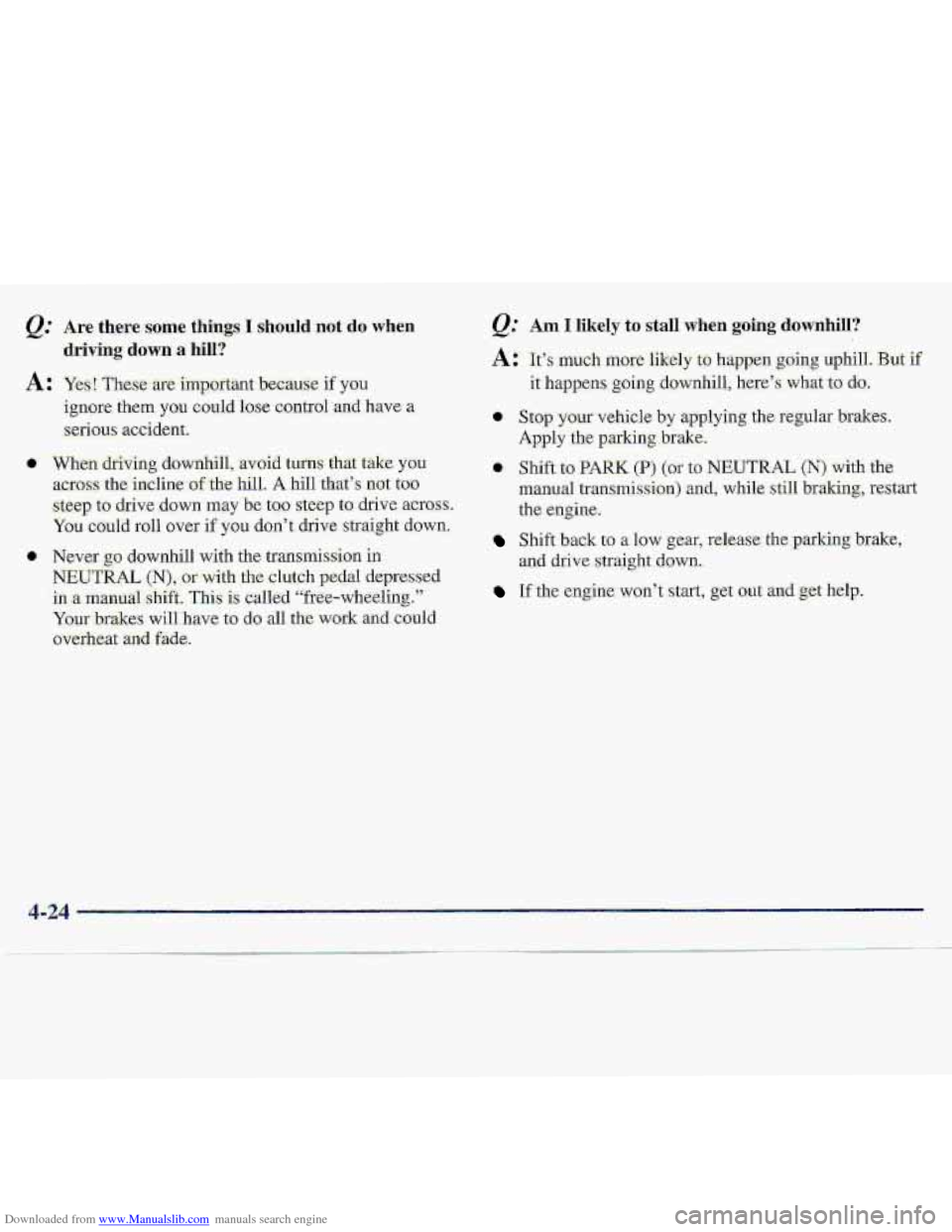
Downloaded from www.Manualslib.com manuals search engine Q.’ Are there some things-I should notdo when
A: Yes! These are important because if you
.driving ’down a hill?
ignore them you could lose control .and have a
serious accident,.
0 When driving downhill, avoid turns that take you
across the incline of the hill. A .hill that’s nut too
steep to drive down may be too steep tQ drive acro:ss.
You could roll over if you don’t drive straight down.
NEUTW (N),.or- with the clutch pedal dep&ssed
in a .manuai~ shift. This is called “free-wheeling.”
Your brakes will. have to do all the work and could
overhe’at and. fade.
0 Never go down-hill with the transmission in:
.Q: Am I likely to stall when going downhill?
A: It’s much more likely to happen ,going uphill. But if
it.happens
going downhill, here’s: what to do.
0 Stop your vehicle by applying the- regular brakes.
Apply the parking brake.
Shift to
PARK. (P) (.or to NEUTRAL (N) with the
manual transmission) and, while still
braking, restart
the engine. ..
S.hift back to a 1.0w gear, release the parking brake,
and drive straight down.
If the engine- won’t start, get out and get. help.
4-24
Page 165 of 402
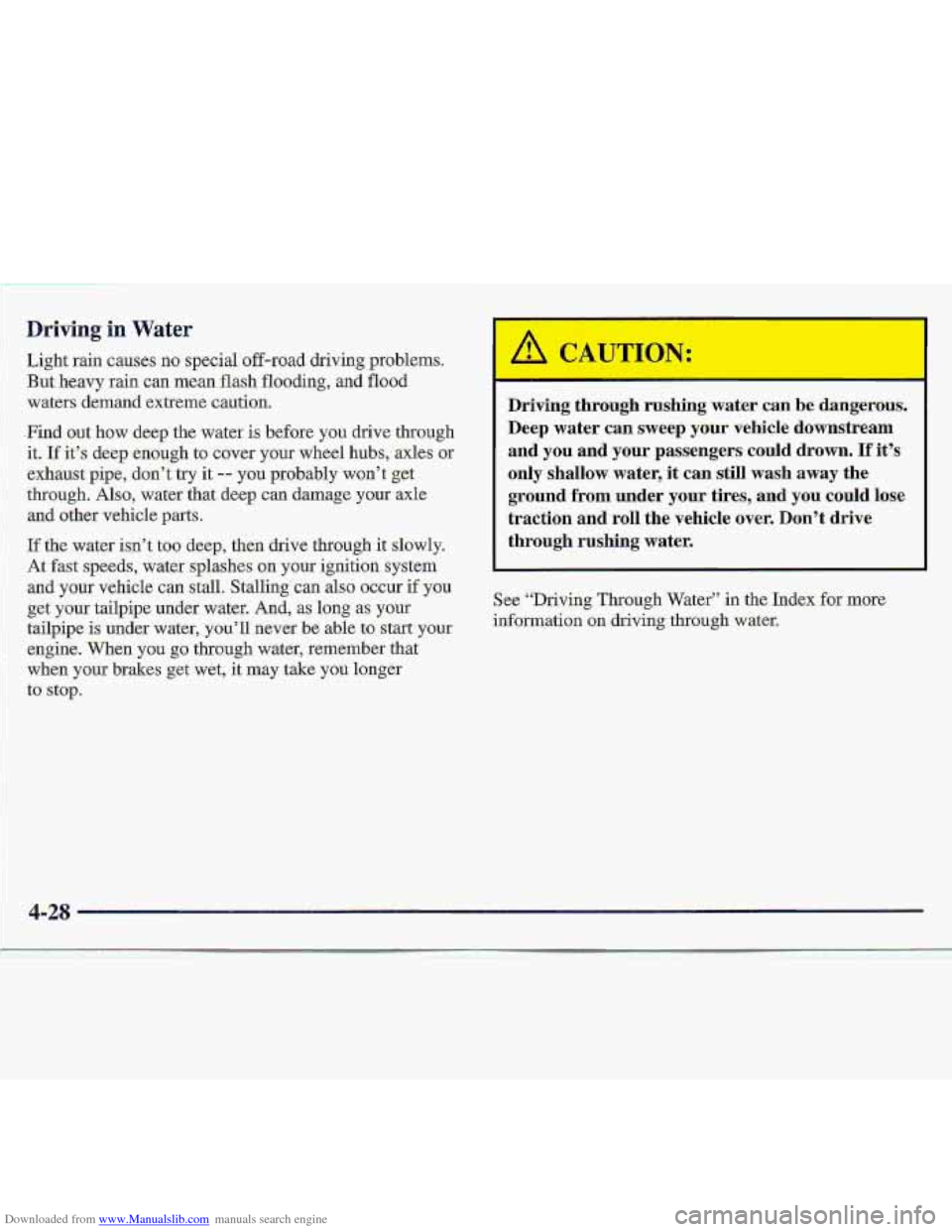
Downloaded from www.Manualslib.com manuals search engine Driving in Water
Light rain causes no specialaff-road driving problems.
But .ke.avy rain
can .mean flash flooding, and flood
waters demand extreme caution.
+Find- out how deep the water is before you drive through
it. If it’s deep enough to cover your wheel hubs, axles or
exhaust pipe, don’t
‘try it -- you probably won’t g-et
through. Also, water that deep
can damage your axle
and
other vehicle parts.
If the water isn’t too deep, then drive through it slowly.
At fast speeds, water splashes on your ignition system
and your vehicle
can st-dl. Stalling.can also occur if you
get your tailpipe under water. And, as long as your
:.. . tailpipe is ,under water, .you’ll never be able to start your
..;;&I
engine. When you gp through water, remember that
--.
. ,. , when your brakes get wet; it may take you longer
to stop. -‘a:i <,..,..?, ,
Driving through rushing water can be dangerous.
Deep water can
sweep your vehicle downstream
and you
and your passengers could drown. If it’s
only shallow water,
it can still wash away the
ground
from under your tires, and you could lose
traction and roIl the vehicle over.
Don’t drive
through
rushing water.
See “Driving Throagh Water” in the Index f6TmGE
infoination on driving through water,
4-28
Page 169 of 402
Downloaded from www.Manualslib.com manuals search engine Driving too fast through large water puddles or even
going through same car washes can cause problems, too.
. . . The water may affect your brakes. Try to avoid puddles.
: 1
: .:I But-if you can't, try to slow da.wn before you hit them.
Wet brakes can cause accidents. They won't work
as well
in a quick stop and may cause pulling tu
one side. You could lose control of the vehicle.
After driving through a large puddle
of water or
a car wash, apply your brake pedal lightly until
your brakes work normally.
Page 175 of 402
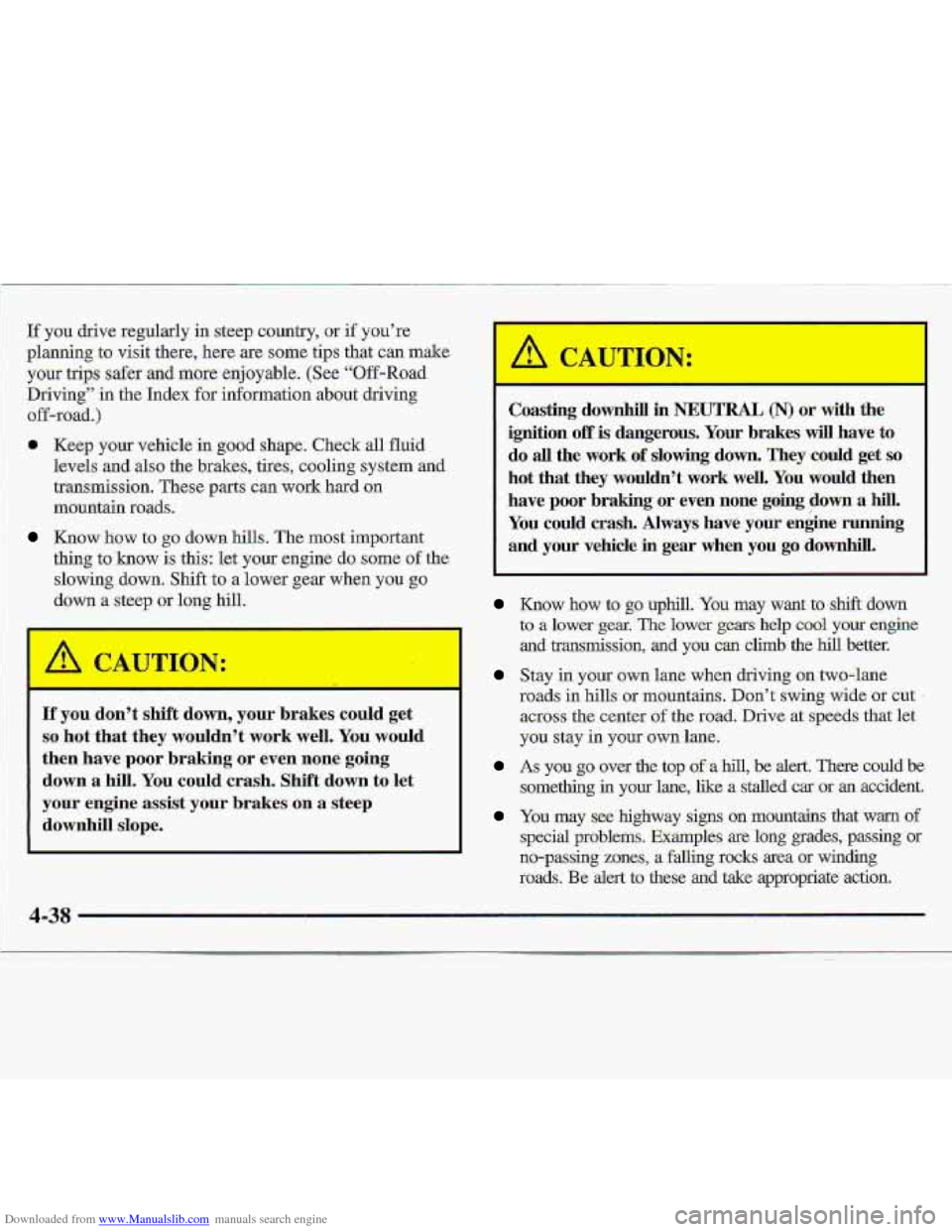
Downloaded from www.Manualslib.com manuals search engine If you drive regularly in steep country, or if you're
planning to visit there, here are some tips that can make
your trips safer-and more enjoyable. (See "Off-Road
Driving" in the Index
for information ab.out driving
off-road.)
Keep your vehicle in good shape; Check all fluid
levels and
also the brakes, tires, cooling system and
transmission. These pqrts
@a work hard on
mountain roads.
Know how to go down hills. The most important
thing
to 'know is this: let: your engine do. some of the
slowing. down. Shift
-to a lower gear when you go
down
a steep or long hill.
If you .don't shift down, your brakes could get
so hot that,they wouldn't work well. You would
then have
po.or braking or even none going
down
a hill. You could crash. Shift down to let
your engine assist your brakes .on a steep
downhill
slope.
I
Coasting downhill in NEUTRAL (N) or WILII the
ignition
off is dangerous. Your brakes will have to
do all the work of slowing down. They could get so
hot that they wouldn't work wen. You would then
have poor braking
or even none going down a hill.
You could crash. Always have your enbe running
and your vehicle in gear when you go downhill.
Know how to go uphill. You may want to-shift down
to a lower gear. The lower gears help cool your engine
and transmission, and you can climb the hill better.
Stay in your own lane when driving on two-lane
roads
in hills- or mountains. Don't swing wide or cut I
across the center-of the road, Drive at speeds that let
-you stay in your own lane.
As YOU go over the top of--a hill, be alert. There could be
something in your lane, like a stalled car or an accident.
YQU may see highway signs an mountains that warn of
special problems. Examples are long grades, passing or
no-passing zones, a falling rocks area or winding
roads. Be alert to these and take appropriate action.
4-38
Page 177 of 402
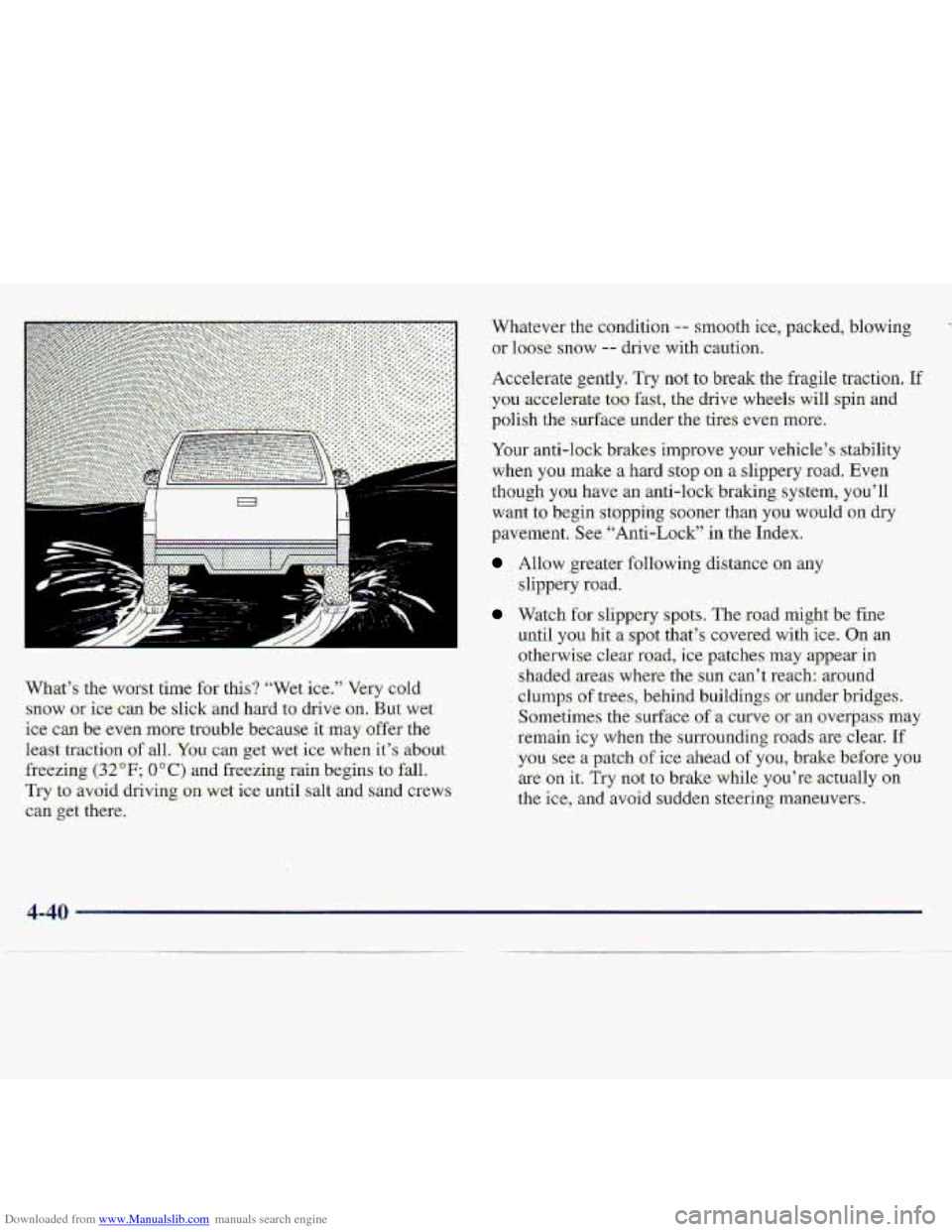
Downloaded from www.Manualslib.com manuals search engine Wh8t’s:the worst time for this? “Wet-.ice.” Very cold
snow or-ice-can be slick and hard to drive on. But wet
ice c.m- be even m-ore. trouble be-cause -it ‘may .offer the
1-east iraction
of all. You can get wet ice when it’s about
fxce.zag C32”F; 0°C) .and fieeziag rain begins tQ fall.
Try to avoid driving .on wet ice untG salt and sand crews
can get there.
Whatever:the G-ondition -- smooth ice, packe.d, blowing
or loose: snow -- drive with Cautibn.
Accelerate gently. Try
not to break the fragile. traction. If
you accelerate t6o fait, the dr5v-e whee1.s will spin-and
polish the -surface under the tires even more..
Your anti-lock brakes improve your vehicle’s stability
when you,make-
a hard stop on a slippery road. Even
tho.ugh you have an anti-lock brxking system, you’ll’
want to begin
stopping sooner tha-n you would on dry
pavement. S,ee: “Anti-Lo-ck” in the Index.
Allow greater following distance :on any
slippery road.
Watch for dippery spots. The road might be fine
until you hit a,spat.th&s covered. with ice. Qn an
.otherwise clear road,: ice -patches may app-ear in
shaded areas where the
sun mn’t reach/ arou-nd
clump>s of. trees, :behind buikdings under bridges.
Sometiines the:surface of a curve air an overpa% may
remain icy when the surrounding raxds are clear. If
you see a-patch &ice ahead of YOLI-, brake:before you
axe on it, Try notto brake while you’=re .actually on
.the ice, .and avoid sadden st_e.Gring maneuvers.
Page 180 of 402
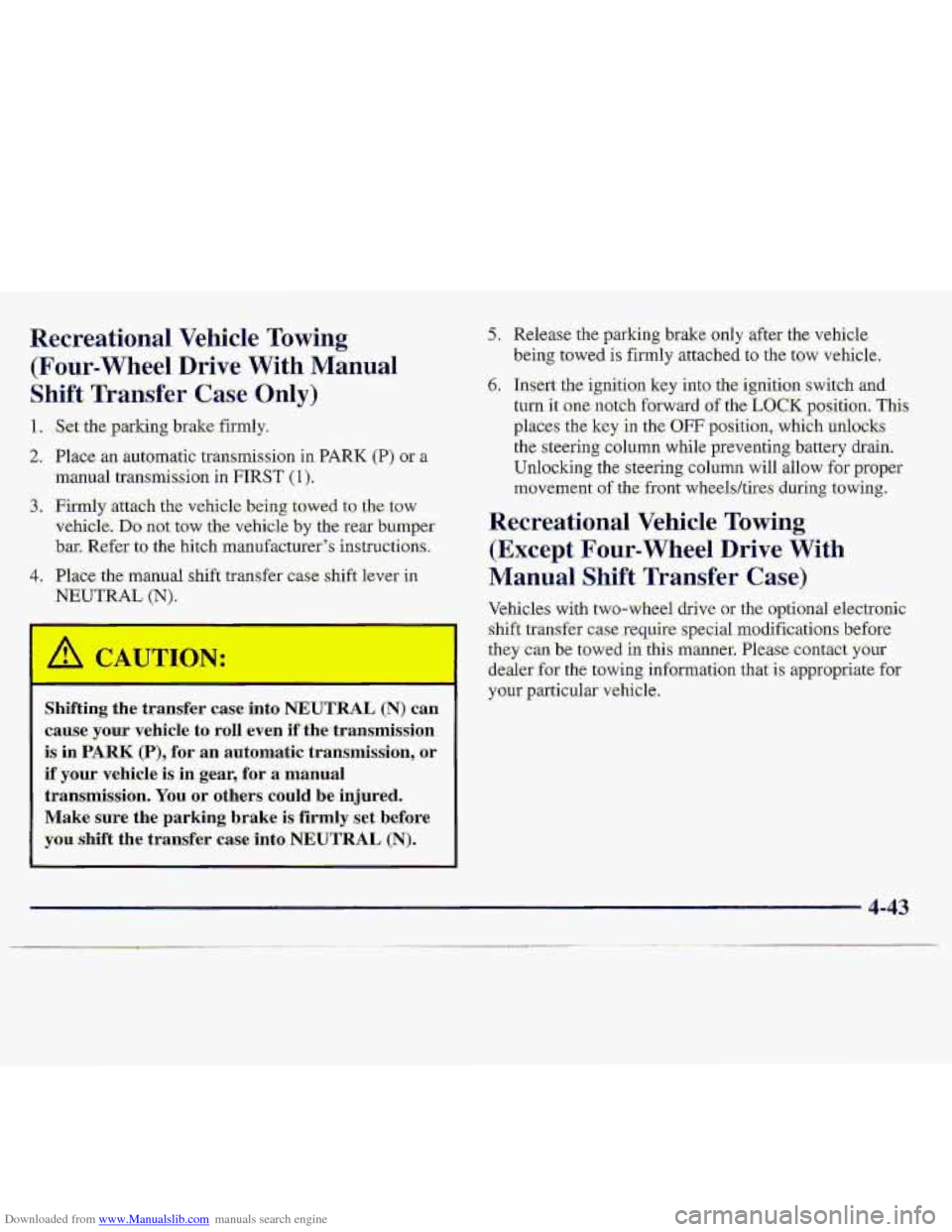
Downloaded from www.Manualslib.com manuals search engine Recreational Vehicle Towing
(Four-wheel Drive With Manual
Shift Transfer Case Only)
1 * Set the 1 'king brake: firmly.
2. Place an auromatic transmission in PARR (P) qr a
-manual transmis'siori in FIRST (1).
3. Firmly attach the vehicle .being towed to the 'to,w
vehick. Do not tow the. v&icle by the rear bumper
bar. Refer to the hitch manufactu.rer's instructions.
4. Place the manual shift transfer case- shift lever in
'NEUTRAL (N).
Shifting the transfer case into NEUTRAL (N. an
cause your vehicle
to roll evenif the transmission
is in PARK (P), for an automatic transmission, or
if your vehicle is in gear, for a manual
transmissi6n.
You or othets could be injured.
Make sure the-parking brake is firmly .set befbre
you shift the transfer case into NEUTRAL (N).
5. Release the parking brake only after the -vehicle,
being
towed is firmly attache-d to the tow vehicie.
6; Ins-ert thei-gnitiaa key into the ignitim switch md
turn it one notch fixward of the LOCK position. This
places the key in the OFF po'sitiofi; which 'ufilocks
the steering column while preventing battexy draia.
Unlocking the
steering column will allow for proper
rnovemcnt of the:front w'beel.s/tirr;s during towing.
R-ecre.ationa1 Vehicle Towing
(Except Four-Wheel Drive With
Manual Shift Transfer Case)
4-43
Page 186 of 402
Downloaded from www.Manualslib.com manuals search engine Towing -a Trailer
I
11 you don’t use the correct equipment and. dr-ive
pruperly,
you can lose control when you pull a
trailer. For ex.ample, if the trailer is too heavy, the
brakes may not work well
-- or, even at all. You;
and your passengers could be seriously injured.
Pull a trailer only if-you have followed ail tIie
ste:ps in
this sectiw. Ask your GM dealer for
advice and information about towing a trailer
with your vehicle.
NOTICE:
Pulling a: trailer improperly can damage your
vehicle and result
in costly repairs not covered by
your warranty. To puli a trailer correctly, follow
the advice in this part, and see your.
GM dealer
for important Information about towing a trailer
with your vehicle.
4-49